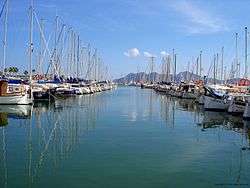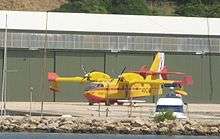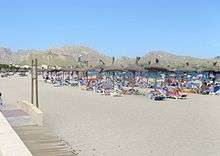Port de Pollença

Port de Pollença (Catalan pronunciation: [ˈpɔrd də poˈʎɛnsə]) (Puerto Pollensa in Castilian Spanish) is a small town in northern Majorca, Spain, situated on the Bay of Pollença. It is located about 6 km east of the inland town of Pollença and two kilometres southeast of Cala Sant Vicenç. The Cap de Formentor is connected to Port de Pollença via a 13.5 km road.
Geography
Port de Pollença is the most northerly town in Majorca. It is split into several main areas: Pine walk, Boquer, Central, Siller, Pinaret, Llenaire and Gotmar. The scenic Boquer Valley runs north-east from the town, near the ruins of the pre-Roman city of Bocchoris, one of the oldest settlements on the island.
The Pine walk

The Pine Walk[1] fronts onto a sheltered part of the larger Badia de Pollença. It is the most popular walk around the coastal line of the town and features a bronze bust of the artist Hermenegildo Anglada Camarasa. Near the end of the Pine Walk stands the old Military Base, home of a number of fire fighting aircraft.
Military Base
During the Spanish Civil War, the base was supporting National Spanish Seefliegerstaffel aircraft from the German Condor Legion, for instance, a number of Heinkel He 59.[2] Nowadays, a number of amphibious fire fighting aircraft, typically Canadair CL-215, are based to the north of the town and can often be seen on exercise around the bay.
Central
The main square Plaça Miguel Capllonch, named and featuring a bronze bust of pianist and composer Miquel Capllonch Rotger, is surrounded by restaurants, shops and bars, with the Church of Our Lady of Carmen lying to the west. A weekly market, held on Wednesdays, sees the square filled with traders selling fruit, fish, clothing and crafts.
Southern

To the south, there is a large, older urbanisation, consisting of three areas: Urban El Pinaret, Urban Gotmar and Urban Llenaire. The area is made up mainly of flats, small hotels and private homes, and has slowly developed over the years. The beach around the area is family friendly, with a gentle grade into the sea, water sports and a wide promenade suitable for walking and cycling.
Highways
A bypass links the main road into the town PM-220 Carretera Pollença north to the PM-221 following a scenic route along the Cap de Formentor.
Culture
Many artists and celebrities have made Port de Pollença their home, or made short trips to the bay during their life. Famous painters such as the Argentinian Atilio Boveri and Hermenegildo Anglada Camarasa lived in Port de Pollença and popularized the place.
Famous writers such as Ruben Darío visited the place in the early 1900s and wrote a number of poems while on the island. Recently, the Peruvian writer Mario Vargas Llosa stayed at the Hotel Formentor.
The most famous example of a renowned writer is perhaps that of Agatha Christie. In the early 20th century, she visited the town and stayed at a hotel in the Pine Walk area, which she describes in her book Problem at Pollensa Bay and Other Stories:
... a small hotel standing on the edge of the sea looking out over a view that in the misty haze of a fine morning had the exquisite vagueness of a Japanese print.
Gallery
_03_ies.jpg) Pollensa Bay
Pollensa Bay- Sunrise across Port de Pollença
- Views over the harbour
 Beach about Llenaire
Beach about Llenaire- Finca de Boquer, near Boquer Valley
- Pinewalk
- The Pine Walk
- The small beach
- The Pine Walk at night
References
| Wikimedia Commons has media related to Port de Pollença. |
Coordinates: 39°54′27″N 3°04′53″E / 39.90750°N 3.08139°E